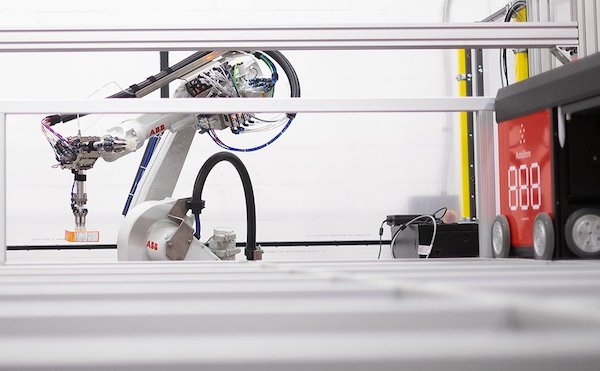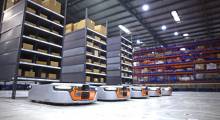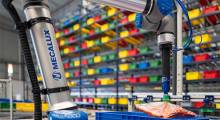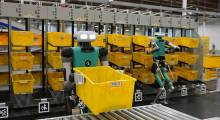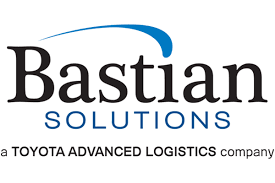In the early 2000s, e-commerce continued to grow into just about every type of vertical and market, shining a light on the value of speed, accuracy, and order customization. Excelling at those factors drives success. In the past decade, order fulfillment lead times have become increasingly aggressive, with suppliers promising as quick as one-hour delivery or in-store pickup of goods.
As customers load their virtual shopping carts with an array of items, optimizing the order-fulfillment process is a priority for many organizations looking to be one step (or click) ahead of their competitors.
To meet the need for shorter times between order and delivery, packaging and material handling technologies have rapidly evolved.
While current strategies such as warehouse execution systems (WES), sortation, rainbow palletizing, and goods-to-person (GTP) systems have certainly helped meet these aggressive order-fulfillment goals, new automation is proliferating and can further improve operations and customer satisfaction.
Integrated robots and ASRS optimize order fulfillment
By integrating piece-picking robots with the back end of an automated storage and retrieval system (ASRS), experienced integrators can turn a GTP system into a highly efficient goods-to-robot (GTR) system. This fully automated solution can improve the speed and flexibility of custom order fulfillment while simultaneously reducing the amount of labor associated with order picking.
In today’s environment, this allows end users to allocate their workforce to more value-added services and improve job satisfaction and retention.
Bin-picking robots can autonomously pick items from donor bins with over 99.9% accuracy and place the ordered items into adjacent shipping cartons or downstream equipment, such as unit-sortation systems.
Robotic bin picking applications generally involve the following components:
- Six-axis robotic arm
- Custom end-of-arm tool (EOAT)
- AI powered machine vision
- Integration with the WES
AI enables a comprehensive, intelligent system
Unlike traditional industrial robotic applications, these bin-picking robots aren’t trained to do a singular task with set inputs and outputs. Thanks to artificial intelligence, the robots can problem solve for an infinite amount of new and complex situations, like new SKU integration, with no training required.
When an inventory bin is presented to the machine vision system, a photo is taken to map out the objects’ orientations. Within a split second, AI vision identifies the “most pickable” object and releases the robot to pick it.
Robotic controls manipulate the arm and EOAT inside the tote. The robot suction or a gripper to pick the targeted object without encroaching on other objects or the tote walls. The robot then retracts the object from the bin and places it in a secondary shipping carton. It is ready for another pick-and-place sequence.
With nearly infinite variability in SKU geometry, orientation, graphics, etc., the AI learns and improves on every single cycle. To multiply that affect, all robots that are connected to the AI platform benefit from the learnings of the other robots. Therefore, as the fleet of robots increase in size, the learnings and performance of the AI and the robots accelerate, giving the end user a higher return for their investment.
AI powers robotic applications
AI-enabled robots have applications reaching far beyond just order fulfillment. The ability to autonomously pick and place can improve operations in the following areas:
- Singulation of product to be placed on to an item sorter or a simple take-away conveyor
- Robotic sortation (robotic putwall)
- Robotic depalletization of single SKU and completely mixed pallets
More than just robots, a solution partner
Putting yourself on the leading edge of fully automated order fulfillment requires more than simply adding robots to your warehouse. A one-size-fits all approach to integration can lead to slow and ineffective systems.
As a stand-alone solution, these each picking robots can add value to your order-picking process. However, further integration into the WES, like Bastian’s Exacta software, can allow you to maximize the value of the robotic automation by directing individual products to the areas that process them in the most efficient manner.
As an independent integrator, Bastian Solutions has the experience needed to seamlessly integrate AI-powered robotic systems with your current equipment and software to ensure optimal results.

About the author
Matt Kohler solutions director of applications at Bastian Solutions, has been with the company since 2005, after receiving his degree in mechanical engineering from the University of Missouri-Columbia. The applications team at Bastian Solutions prides itself on thoroughly understanding its customers' unique needs. It then tailors systems to give those businesses a competitive edge.
Article topics
Email Sign Up

